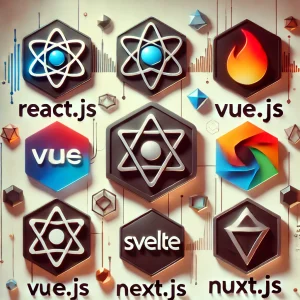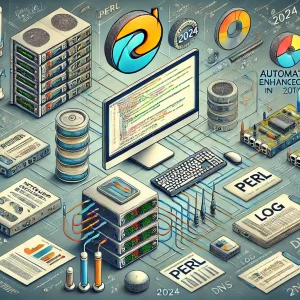
JavaScript remains a cornerstone of modern web development, continually evolving to meet the dynamic demands of the industry. As we delve into 2024, several JavaScript frameworks stand out for their capabilities, community support, and innovative features. In this blog, we’ll explore the top JavaScript frameworks for modern web development in 2024, highlighting their unique advantages, use cases, and what sets them apart in the ever-evolving landscape.
1. React.js
Overview: React.js, maintained by Facebook, continues to dominate the front-end development landscape. Its component-based architecture and virtual DOM have made it a favorite among developers for creating dynamic and responsive user interfaces.
Key Features:
- Component-Based Architecture: React’s modular approach allows developers to build encapsulated components that manage their own state, making code reusable and easier to maintain.
- Virtual DOM: React’s virtual DOM enhances performance by minimizing direct manipulation of the actual DOM, leading to faster rendering.
- Rich Ecosystem: With tools like Create React App, React Router, and Redux, the React ecosystem is robust, supporting a wide range of development needs.
Use Cases:
- Single Page Applications (SPAs): React is ideal for SPAs due to its efficient rendering and state management capabilities.
- Mobile Applications: With React Native, developers can use React to build cross-platform mobile apps.
2024 Trends:
- Server Components: New experimental features like server components aim to simplify data fetching and server-side rendering.
- Concurrent Mode: Enhancements in concurrent mode will further improve React’s performance and user experience.
In the realm of JavaScript frameworks for modern web development in 2024, React.js continues to be a top contender due to its innovative features and strong community support.
2. Vue.js
Overview: Vue.js, created by Evan You, has garnered a significant following for its simplicity and flexibility. Vue’s gentle learning curve and powerful features make it a strong contender in the JavaScript framework arena.
Key Features:
- Reactive Data Binding: Vue’s reactive data binding makes it easy to synchronize data between the model and the view.
- Single-File Components: Developers can define HTML, JavaScript, and CSS in a single file, enhancing productivity.
- Vue CLI: The Vue Command Line Interface (CLI) simplifies project setup and scaffolding, making it easier to get started with Vue.
Use Cases:
- Progressive Web Apps (PWAs): Vue’s progressive nature allows it to be integrated incrementally into projects, making it perfect for PWAs.
- Interactive User Interfaces: Vue’s flexibility makes it suitable for building interactive user interfaces and data-driven applications.
2024 Trends:
- Vue 3 Adoption: With the stable release of Vue 3, features like Composition API and improved TypeScript support are expected to drive adoption.
- Enhanced Tooling: Ongoing improvements in Vue CLI and Vue DevTools will continue to streamline development workflows.
Vue.js stands out among JavaScript frameworks for modern web development in 2024 due to its ease of use and adaptability.
3. Angular
Overview: Angular, developed and maintained by Google, is a comprehensive framework for building large-scale applications. Its opinionated structure and extensive tooling make it a preferred choice for enterprise-level projects.
Key Features:
- TypeScript Support: Angular is built with TypeScript, offering robust type-checking and improved code quality.
- Dependency Injection: Angular’s dependency injection system enhances modularity and testability.
- Angular CLI: The powerful Angular CLI automates many aspects of development, from project setup to deployment.
Use Cases:
- Enterprise Applications: Angular’s structured framework is ideal for large, complex applications requiring a high degree of maintainability.
- E-commerce Platforms: Angular’s performance and scalability make it suitable for e-commerce websites with dynamic content and high traffic.
2024 Trends:
- Ivy Renderer: Continued enhancements to the Ivy renderer will improve performance and bundle size.
- Standalone Components: Upcoming features like standalone components aim to simplify Angular’s module system.
Among JavaScript frameworks for modern web development in 2024, Angular is notable for its robust structure and suitability for large-scale projects.
4. Svelte
Overview: Svelte, created by Rich Harris, offers a fresh approach to front-end development by shifting much of the work to compile time. This results in highly optimized, minimalistic runtime code.
Key Features:
- Compile-Time Optimizations: Svelte compiles components to efficient imperative code, leading to faster load times and better performance.
- Reactivity: Svelte’s reactivity model is straightforward, allowing developers to write less code and achieve more.
- Zero Runtime: With no virtual DOM, Svelte apps are smaller and faster compared to traditional frameworks.
Use Cases:
- High-Performance Web Apps: Svelte is perfect for applications where performance and load times are critical.
- Small to Medium Projects: Its simplicity and efficiency make Svelte suitable for small to medium-sized projects where quick development and performance are key.
2024 Trends:
- SvelteKit: SvelteKit, the official framework for building Svelte applications, is gaining traction for its powerful features and ease of use.
- Increased Adoption: As more developers recognize Svelte’s performance benefits, its adoption is expected to grow significantly.
Svelte is gaining attention among JavaScript frameworks for modern web development in 2024 for its innovative compile-time optimizations and simplicity.
5. Next.js
Overview: Next.js, built on top of React, has emerged as a leading framework for server-side rendering (SSR) and static site generation (SSG). Developed by Vercel, Next.js simplifies complex front-end requirements.
Key Features:
- Hybrid Rendering: Next.js supports both SSR and SSG, offering flexibility in rendering strategies.
- API Routes: Built-in API routes enable developers to create backend functionality within a Next.js application.
- Automatic Code Splitting: Next.js automatically splits code for faster page loads and better performance.
Use Cases:
- SEO-Optimized Sites: Next.js’s SSR capabilities make it ideal for building SEO-friendly websites.
- E-commerce Platforms: Its performance optimizations and dynamic rendering are beneficial for e-commerce sites requiring quick load times and dynamic content.
2024 Trends:
- Edge Functions: Integration with edge functions will enable even faster server-side rendering and reduced latency.
- Enhanced Developer Experience: Continuous improvements in the Next.js framework and Vercel platform will enhance developer productivity and performance.
Next.js is a standout among JavaScript frameworks for modern web development in 2024, offering powerful SSR and SSG capabilities.
6. Nuxt.js
Overview: Nuxt.js extends Vue.js with server-side rendering, static site generation, and a host of other powerful features. It’s designed to make web development simpler and more efficient.
Key Features:
- Server-Side Rendering: Nuxt’s SSR capabilities improve performance and SEO.
- Static Site Generation: Nuxt can generate static sites for even faster load times and better scalability.
- Modular Architecture: Nuxt’s modular architecture allows for easy integration and customization of features.
Use Cases:
- Content-Driven Sites: Nuxt’s SSR and SSG make it ideal for content-driven websites and blogs.
- Performance-Critical Applications: Applications requiring high performance and SEO benefits from Nuxt’s optimized rendering.
2024 Trends:
- Nuxt 3: The release of Nuxt 3 promises improved performance, better developer experience, and new features like Vite integration.
- Headless CMS Integration: Ongoing enhancements in integrating with headless CMS solutions will streamline content management workflows.
Nuxt.js is an essential player among JavaScript frameworks for modern web development in 2024, offering robust SSR and SSG features.
Conclusion
The landscape of JavaScript frameworks is vibrant and continually evolving. Each framework mentioned here brings unique strengths to the table, catering to different project requirements and development styles. In 2024, developers have a rich selection of tools to choose from, enabling them to build modern, efficient, and scalable web applications. Whether you’re working on a large enterprise project, a dynamic single-page application, or a high-performance static site, there’s a JavaScript framework tailored to your needs. Stay updated with the latest trends and enhancements in these frameworks to leverage their full potential in your web development projects.
JavaScript frameworks for modern web development in 2024 offer unprecedented capabilities, ensuring that developers can create highly performant, maintainable, and dynamic applications. From the continued evolution of React and Vue to the innovative approaches of Svelte and Next.js, the options available cater to a wide range of development needs and preferences. Embracing these frameworks will undoubtedly equip developers to meet the challenges and opportunities that lie ahead in the ever-evolving world of web development.





